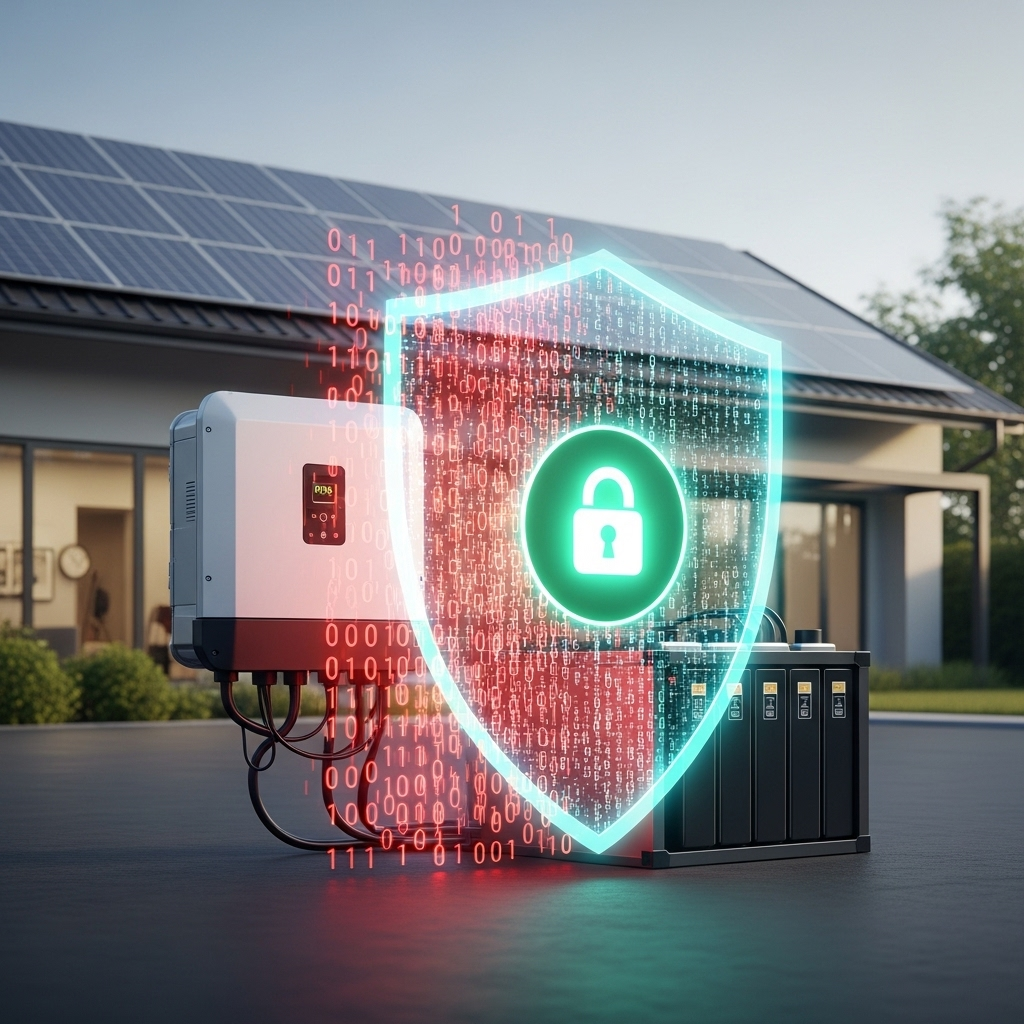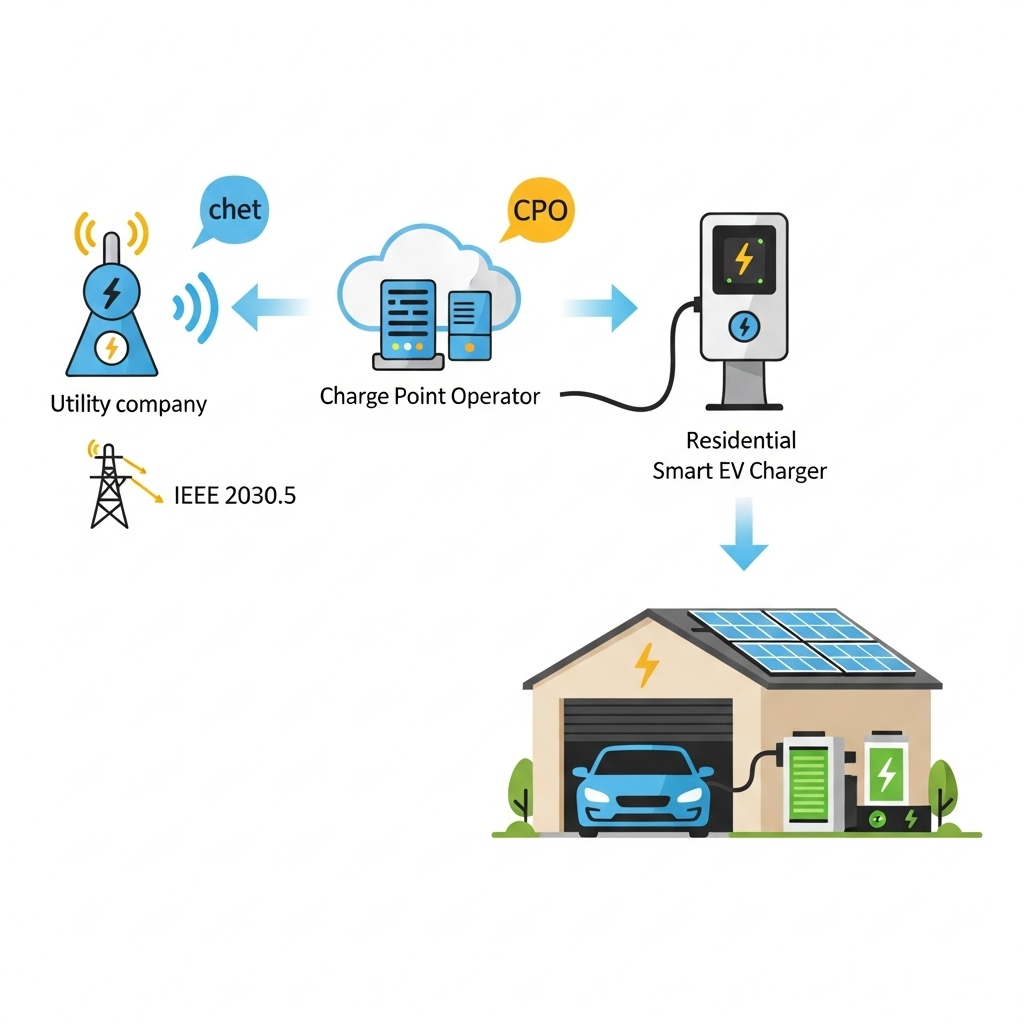Over-the-Air (OTA) updates are a double-edged sword. They deliver vital performance enhancements, new features, and critical security patches to your solar inverter and home Energy Storage System (ESS). At the same time, this remote connection can become a gateway for cyber threats if not properly secured. Protecting this process is not just an IT concern; it's fundamental to the safety, reliability, and longevity of your energy investment.
A compromised update could turn your high-performance asset into a liability. It could lead to system shutdowns, manipulated energy reporting, or in a worst-case scenario, create instability that affects the local grid. This makes robust OTA Update Cybersecurity a non-negotiable feature for modern energy systems.
Understanding the OTA Attack Surface in Energy Systems
When your inverter or ESS receives an update, it opens a temporary communication channel. While this is necessary for progress, it also presents an opportunity for malicious actors. Understanding the vulnerabilities is the first step toward effective Solar Inverter Hardening.
What Makes an OTA Process Vulnerable?
The primary threats to the OTA process are man-in-the-middle (MitM) attacks and the deployment of malicious firmware. In a MitM attack, an attacker intercepts the communication between the manufacturer's server and your device. They could block the update or, more dangerously, replace the legitimate firmware with a compromised version. This malicious firmware could contain anything from spyware to code designed to damage the hardware.
Consequences of a Compromised Update
The impact of a successful attack can range from inconvenient to catastrophic. A 'bricked' device becomes completely unresponsive, requiring a costly physical repair or replacement. More subtle attacks could degrade performance, impacting key metrics like round-trip efficiency. A compromised firmware could drastically reduce your system's efficiency, a key metric detailed in the ultimate reference for solar storage performance. As the Next Generation Wind and Solar Power report from the IEA highlights, inverters are increasingly used to control grid voltage, so a widespread attack could have serious implications for grid stability.
The Core Pillars of Secure OTA Updates
Effective Home ESS OTA Security relies on a multi-layered defense strategy. No single technique is foolproof. Instead, a combination of methods creates a formidable barrier against attacks. These three pillars form the foundation of a secure update mechanism.
1. Code Signing and Digital Signatures
Every firmware update should be digitally signed by the manufacturer. A digital signature is a cryptographic method that acts as a tamper-proof seal. When your device receives an update, it first verifies this signature. If the signature is invalid—meaning the code has been altered in any way since it was signed—the device will reject the update. This is a critical first line of defense against malicious firmware injection.
2. Encrypted Transport Channels
The data packet containing the firmware must travel through a secure, encrypted channel. This is typically achieved using Transport Layer Security (TLS), the same technology that protects your data during online banking. TLS encrypts the data in transit, making it unreadable to anyone who might intercept it. This prevents attackers from snooping on the update process or attempting a man-in-the-middle attack. Inverter Communication Security is impossible without this fundamental layer.
3. End-to-End Firmware Encryption
While TLS protects the data in transit, end-to-end encryption protects the firmware file itself. The firmware is encrypted on the manufacturer's server and can only be decrypted by the target device. This adds another layer of security. Even if an attacker somehow bypasses the TLS channel and downloads the update file, it remains a useless, scrambled block of data without the specific decryption key held securely on your device.
Advanced Hardening Techniques and Best Practices
Beyond the core pillars, advanced techniques provide further resilience and control, ensuring your ESS Firmware Protection is as robust as possible. Reputable manufacturers integrate these features into their system architecture.
Secure Boot and Failsafe Rollbacks
What happens if an update is corrupted during transmission or fails to install correctly? A secure boot process ensures that the device only loads software that is cryptographically verified. If it detects an unverified or corrupt new firmware, it should automatically refuse to boot from it. A robust system will then initiate a rollback, reverting to the last known good version of the firmware. This 'failsafe' prevents the device from becoming inoperable due to a failed update.
Delta Updates for Smaller Attack Surfaces
Instead of sending the entire firmware image (which can be large) for every minor patch, many systems use delta updates. These updates contain only the changes between the old and new versions. This approach offers two key benefits. First, the smaller file size reduces transmission time and data usage. Second, it presents a much smaller attack surface, making it more difficult for an attacker to analyze and reverse-engineer the changes.
Granular Access Control and Authentication
Not everyone should be able to initiate a firmware update. Secure systems implement strict access control. Updates should only be initiated from authenticated manufacturer servers. For users or installers with administrative access, initiating an update should require strong authentication, such as multi-factor authentication (MFA). This prevents an attacker who has stolen simple login credentials from pushing a malicious update to your system.
| Security Feature | Insecure OTA Process | Secure OTA Process |
|---|---|---|
| Transmission | Unencrypted (HTTP) | Encrypted Channel (TLS/HTTPS) |
| Firmware File | Plaintext | End-to-End Encrypted |
| Verification | None or basic checksum | Cryptographic Signature Verification |
| Installation | Overwrites old firmware directly | Secure Boot with Rollback Capability |
| Initiation | Anyone with basic credentials | Strong Authentication (MFA) and Server Whitelisting |
Your Role in Maintaining a Secure System
While manufacturers are responsible for building secure systems, you, the owner, also play a crucial part in maintaining that security. Cybersecurity is a shared responsibility. The U.S. Department of Energy's research on solar energy emphasizes the need for robust IT and operational technology (OT) practices as distributed energy resources become more common.
Choose Manufacturers with a Security-First Mindset
When selecting an inverter or ESS, ask about the company's security practices. Do they publish a security policy? Do they use the techniques described above, like code signing and encrypted transport? A manufacturer who prioritizes and is transparent about their cybersecurity measures is making a clear commitment to protecting your investment.
Secure Your Home Network
Your home ESS and inverter connect to the internet through your local network, typically Wi-Fi. If your network is insecure, it can become the weakest link. Ensure your Wi-Fi router uses strong WPA3 or WPA2 encryption, has a complex and unique password, and that its own firmware is kept up to date. Consider placing your energy devices on a separate, isolated network segment if your router supports it.
Monitor System Logs and Alerts
Familiarize yourself with your system's monitoring portal. Reputable systems will log major events, including firmware updates. Set up alerts for update activities. An unexpected update notification or repeated failed update attempts could be an early warning sign of a potential issue that warrants further investigation.
Building a Resilient Energy Future
Securing OTA updates is a critical component of overall solar and storage system resilience. It's not a one-time fix but an ongoing process of vigilance from both the manufacturer and the end-user. By implementing layers of security—from code signing and encryption to secure boot and user-side network hygiene—we can ensure that the devices powering our homes remain safe, reliable, and efficient. Protecting the digital integrity of your inverter and ESS is just as important as protecting the physical hardware. It is the key to unlocking a truly independent and secure energy future. As organizations like IRENA advocate for smarter and more interconnected power grids, the security of each individual node, including your home system, becomes paramount for collective stability.
Frequently Asked Questions
General OTA Security
What is an OTA update?
An Over-the-Air (OTA) update is the wireless delivery of new software, firmware, or other data to devices like solar inverters and home energy storage systems. It allows manufacturers to add features, improve performance, and apply security patches remotely without requiring a technician to visit.
Why is OTA update security so important for a solar inverter?
A solar inverter is a critical component that manages energy flow from your solar panels to your home and potentially the grid. A compromised OTA update could allow an attacker to shut down your system, manipulate its operation, or even attempt to destabilize the local power grid, making robust security essential for safety and reliability.
Technical Security Measures
How does code signing work?
Code signing uses a digital signature, which is a cryptographic process where the manufacturer uses a private key to create a unique signature for a firmware file. The inverter or ESS has a corresponding public key. When it receives the update, it uses the public key to verify the signature. If the file was altered in any way, the verification fails, and the update is rejected.
Is HTTPS/TLS enough to secure an OTA update?
While using an encrypted channel like TLS is a critical step, it's not sufficient on its own. It protects the data while it's in transit. However, if the firmware file itself is not encrypted, it could be vulnerable if an attacker gains access to the server where it's stored. A multi-layered approach combining channel encryption, firmware encryption, and code signing is the best practice for comprehensive ESS Firmware Protection.





Leave a comment
All comments are moderated before being published.
This site is protected by hCaptcha and the hCaptcha Privacy Policy and Terms of Service apply.